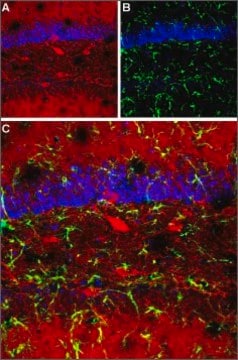05-474
Anti-GABA A Receptor β2/3 Antibody
clone 62-3G1, Upstate®, from mouse
Synonym(s):
GABA(A) receptor subunit alpha-1, gamma-aminobutyric acid (GABA) A receptor, alpha 1, gamma-aminobutyric acid A receptor, alpha 1
About This Item
Recommended Products
biological source
mouse
Quality Level
antibody form
purified antibody
antibody product type
primary antibodies
clone
62-3G1, monoclonal
species reactivity
rat, bovine, human
manufacturer/tradename
Upstate®
technique(s)
immunohistochemistry: suitable
immunoprecipitation (IP): suitable
western blot: suitable
isotype
IgG
UniProt accession no.
shipped in
wet ice
target post-translational modification
unmodified
Gene Information
human ... GABRA1(2554)
General description
Specificity
Immunogen
Application
Immunohistochemistry: This antibody has been reported to detect the GABAA Receptor β2 and β3 subunits in paraffin embedded and frozen rat brain sections which had been fixed with 4% paraformaldehyde or 0.1% glutaraldehyde and permeabilized with Triton X-100.
Neuroscience
Neurotransmitters & Receptors
Quality
Western Blot Analysis: 0.5-2 μg/mL of this antibody detected the GABAA Receptor β2 and β3 subunits from 20 μg of rat brain microsomal preparation (Catalog # 12-144).
Target description
Physical form
Storage and Stability
Analysis Note
Brain tissue
Other Notes
Legal Information
Disclaimer
Not finding the right product?
Try our Product Selector Tool.
recommended
Storage Class
10 - Combustible liquids
wgk_germany
WGK 1
Certificates of Analysis (COA)
Search for Certificates of Analysis (COA) by entering the products Lot/Batch Number. Lot and Batch Numbers can be found on a product’s label following the words ‘Lot’ or ‘Batch’.
Already Own This Product?
Find documentation for the products that you have recently purchased in the Document Library.
Our team of scientists has experience in all areas of research including Life Science, Material Science, Chemical Synthesis, Chromatography, Analytical and many others.
Contact Technical Service







